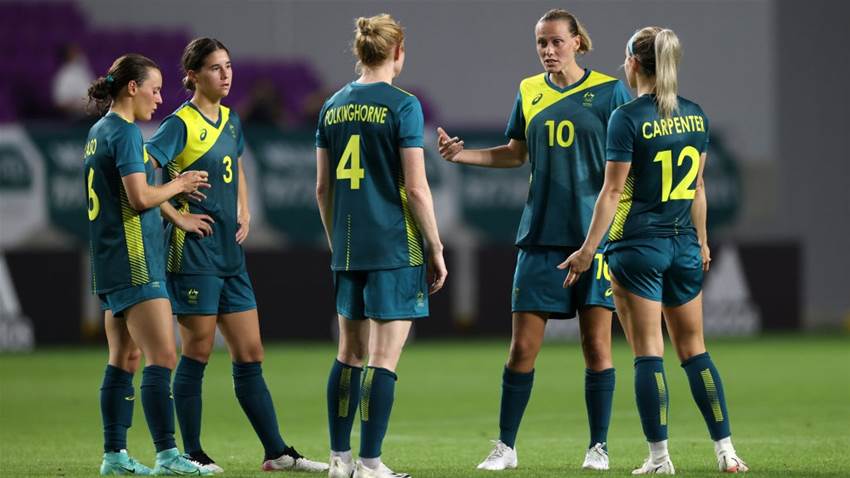The Matildas failed to produce a single win in their 2021 Olympic preparations. Should we once again be worried?
In their final match prior to the upcoming Olympics, the Matildas fell 1-0 to Japan. Again, the winning goal was produced by an Australian error.
Alanna Kennedy’s arm connected with the ball inside Australia’s box and Japan were awarded a free kick. Mana Iwabuchi slotted it home in the 54’ minute to put the Nadeshiko up by a goal. The Aussies were not able to come back from behind.
For the second match in a row the Australian’s coach Tony Gustavsson opted to go with a 3-4-3 formation. This time, comparative to the last Sweden game, the two outside midfielders played slightly further up.
The 3-4-3 formation, which had been successful defensively against Sweden, showed to have disadvantages against Japan.
While it did give more room for creativity up front, by allowing more players to venture forward, it withheld Catley and Carpenter significantly more than one would see in a more conventional 4-3-3 or 4-4-2.
Both players, who are normally full-backs, played as centre backs, the first half flanking Clare Polkinghorne. While both are excellent defenders, and their presence adds defensive speed, one of their best qualities as footballers is their capabilities to bring the ball forward.
Catley and Carpenter did manage to make forward runs several times during the first half, but they did not have the same freedom to make these runs that they normally would in a more conventional back four.
The change with Alanna Kennedy and Aivi Luik at halftime, which saw Catley come off and Carpenter move to the wing position in midfield, showed more promise of how their ball carrying skills could be used during the Olympics as it freed Carpenter to make these runs with less worry about her defensive duties.
When speaking to the press after the match Gustavsson stated: "“We want to be tactically flexible and use Ellie and Steph (Catley) in those two different positions depending on the opponents, depending on what tactics we have”.
Moreover, as comforting as the 3-4-3 was for the Sweden game, specifically in minimizing defensive mistakes and adding speed in the centre of defence for faster attacking opponents, it failed to impress in this match.
At times it left the Matildas exposed out back, especially when an outside centre back from the three grouping moved forward. This occurred several times during the match with Catley, Carpenter and Kennedy finding themselves very high up on the field.
Without proper communication with the defensive midfielder this could be a deadly place to counterattack the Matildas’ for future opponents, as it can lead to only two Aussie defenders left out back. It could be a target point for Matildas’ adversaries during the Olympics.
The 3-4-3 also left the Matildas back three with a lack of passing options. The Nadeshiko were extremely good at applying pressure on the Australian defence, blocking their passing avenues and reducing their capabilities of trying to get the ball out.
It even led to a number of instances where the Australian defenders were defending against their own intercepted clearances and being prone to the counter attack when pressure was properly applied and timed.
The 3-4-3 also left the outside flanks of the defence being very exposed at times. The Japanese used this on a number of occasions, passing balls into the outside spaces. This allowed their attackers to make easier crosses or runs into the Australian box than they normally would be capable of.
Were it not for several stops by Teagan Micah when encountering these short counters in the first half, the scoreline would have been far worse than it was.
Perhaps the most frustrating conundrum right now, more worrying than the defensive errors or tactical formation, is the lack of productivity in offence.
If you look at the total number of shots taken by the Matildas in their five matches this year, they produced 48 shots total with only 17 on goal.
In fact, if you remove the Danish match statistics, which has been an outlier for shots, the Matildas had just 34 shots this year with 7 of them being on goal in their four other matches. That is a total of less than 10 shots a match with less than 2 being on target.
Part of the reason for this is that the Matildas are struggling to bring the ball forward. While one should never put too much emphasis on friendly results, the lack of offensive consistency or capabilities in all five showings is worrying.
The place this is most prevalent, in its display, is the results that have come out of Sam Kerr. She has yet to score this year.
This isn’t to say that Kerr has played badly. What seems to be occurring though is that Gustavsson’s new tactics are not getting the best out of her abilities. In fact, one could easily say they are badly suited to what the Matildas captain can do.
Since the beginning of his reign as Australian coach, Gustavsson’s tactics have led to very little service up to Kerr. The times she was given service, she was often required to bring the ball forward, sometimes out wide, and hold it, again reducing what she is most capable of doing.
While Gustavsson has blamed himself for this failing, stating after the April friendlies that the fault with the lack of service fell to him and his decisions. However the whole offensive situation has not improved.
This last match saw problems that stretched from incapabilities and inconsistencies with regards to getting the ball out from the defence, a lack of link up play and a final pass and shot that needed more work.
While the second half proved more promising, especially after the raft of changes made by Gustavsson and the unleashing of Carpenter in the midfield, the Matildas were not able to capitalise.
While this may make the upcoming Olympics prospect seem gloomy, one thing needs to be remembered about this group of now veteran Matildas.
They have time and time again shown that they have the competitiveness, the grit and the determination to turn things around when times are tough. They certainly have the skill and squad to do this.
They must do it quickly though. For the Matildas to have any chance at exiting the group stage they must take maximum points in their first two matches.
The timeframe for a 180-degree change in outcome has closed.
Related Articles

'Timing not right': Montemurro's verdict on Matildas vacancy

Matildas: 'Fourth at the Olympics is honestly the worst place you could come'
.jpg&h=172&w=306&c=1&s=1)












